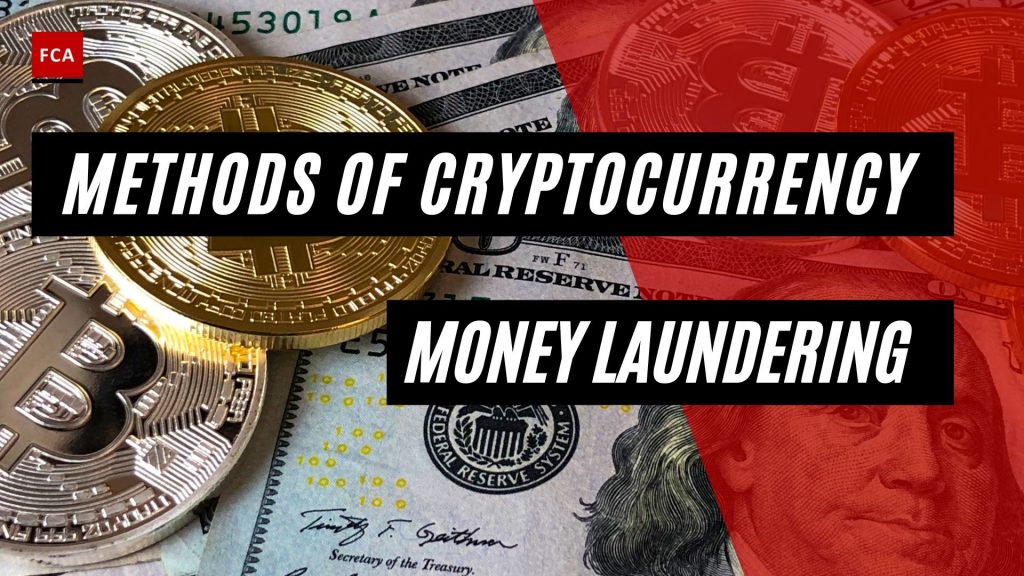The methods of cryptocurrency money laundering. Some of the most prominent cases of cryptocurrency money laundering involve one or more of these methods, sometimes alone standing, sometimes in combination. Inevitably, this knowledge is greatly beneficial to detecting irregular activities and building internal safeguards to protect against cryptocurrency money laundering risk.

Methods Of Cryptocurrency Money Laundering: The 7 Additional Methods Of Cryptocurrency Money Laundering
The first cryptocurrency money laundering method involves using so-called money mules or smurfs.
A money mule is a person that transfers funds on behalf of the money launder. Money launderers usually utilize numerous money mules and break up and divide large funds so they don’t get detected easily. Cryptocurrency money launderers apply the same principle and utilize money mules as well.
They usually do this in 4 quite simple steps.
- The first step is opening verified accounts at crypto exchanges. The money launderer opens numerous accounts using money mules as frontman with false documents to surpass identification and verification. This step will also convert cryptocurrency deriving from illegal activities, such as ransomware and fraud, into fiat currency.
- The second step is transferring the dirty cryptocurrency from crypto addresses or wallets to the exchanges. The money launderers then use tumblers or mixers to transfer the cryptocurrency to the verified account opened at an exchange with false identification documents.
- The third step is opening bank accounts with money mules. The money mules open several bank accounts in a third country with false foreign identification documents. All the documentation associated with opening these bank accounts is then delivered to the money launderer.
- The last step is transferring the cryptocurrency from the exchanges to the local bank accounts opened by money mules. At this stage, the criminal money was already separated from its source. Then money launderer can use the money for whatever purpose. Usually, these bank accounts are used for short periods, and their balance typically does not exceed 30,000 euros.
The second cryptocurrency money laundering is quite simple and involves using prepaid cards.
Believe it or not, nowadays, prepaid debit cards can be loaded with cryptocurrency. Once the prepaid debit card is loaded, the funds can be used to fund different illegal activities. They can be traded for other currencies or handed off to third parties.
The third cryptocurrency money laundering method is relatively simple and involves online gambling.
Numerous online gambling and gaming websites accept cryptocurrencies. Cryptocurrency can be used to buy credit or virtual chips. Usually, the money launderers would play for a few rounds and cash out again after just a few small transactions. By doing so, the money launderer has an explanation for the origin of the funds right away. He can claim that the funds are the proceeds from winning online games.
The fourth cryptocurrency money laundering method is a bit more sophisticated and involves using automated teller machines or ATMs.
As of September 2019, there were 5,457 Bitcoin ATMs worldwide. Continually connected to the internet, Bitcoin ATMs allow anyone with a credit or debit card to purchase Bitcoin. Additionally, they may possess bi-directional functionality enabling users to trade Bitcoins for cash using a scannable wallet address.
Bitcoin ATMs can also accept cash deposits, providing a QR code that can be scanned at a traditional exchange and used to withdraw Bitcoin or other cryptocurrencies. Regulations used by financial institutions to obtain a record of customers and transactions for these machines vary by country and are often poorly enforced. Criminals can exploit loopholes and weaknesses in cryptocurrency ATM management to get around Bitcoin money laundering risks.
Money launderers are increasingly using Bitcoin ATMs to launder illegally obtained money. Previously, banking transfers or remittance services such as Western Union or MoneyGram were used. Now, criminals instruct their money mules to withdraw money from compromised bank accounts and use it to buy Bitcoins via a Bitcoin ATM. To avoid identification procedures, the criminal depositors would apply smurfing techniques to split the funds into batches of under 1,000 euros.

The fifth cryptocurrency money laundering method involves the so-called peer-to-peer networks.
To lower crypto money laundering risk, many criminals turn to decentralized peer-to-peer networks, which are frequently international. Here, they can often use unsuspecting third parties to send funds on their way to the next destination. Most cryptocurrency money laundering schemes end with the clean coin funneled into exchanges in countries with little or no AML regulations. It’s here that they can finally convert it into local fiat and use it to purchase luxury or other high-end items such as sports cars or upscale homes.
The sixth cryptocurrency money laundering method involves using local stores.
Nowadays, the possibility exists to trade cryptocurrencies Face-to-Face. On the internet, it’s possible to find private vendors that wish to sell cryptocurrencies for a small fee. Several sites on the Internet offer to match individuals willing to buy or sell Bitcoins in person. LocalBitcoins.com is the most famous such market places. Some sellers prefer cash as payment while others may allow various forms of payment such as online payment services, bank or money services businesses-transfers, or others.
According to information provided by a European Police Authority, a money-laundering organization was traditionally dedicated to placing and layer criminal funds derived from the trafficking of cocaine from Spain to Colombia via bank account smurfing techniques. Now, it updated its modus operandi and used LocalBitcoins.com to carry out its international transfers.
After picking up considerable amounts of criminal cash from drug traffickers in Europe, this money laundering organization continued to use its smurfing techniques to split and deposit funds into many bank accounts under their control. After several transfers to other bank accounts, the funds were ultimately used to purchase Bitcoins from private vendors in different European countries via the Local Bitcoins platform.
To then move the value of the obtained Bitcoins to Colombia, the money-laundering organization uses two simple options:
- Option 1: On the same day, the money laundering organization resold the number of purchased Bitcoins in the European Union, again using the services of Local.Bitcoins.com. But this time, the Bitcoins were sold to private buyers in Colombia that paid with bank transfers directly into Colombian bank accounts, in Colombian pesos.
- Option 2: On the same day, the LocalBitcoin wallet, where the purchased Bitcoins and the necessary information to access and use the wallet were stored, was delivered to the cocaine trafficking criminal organization in Colombia. They can then use the value stored in that wallet in Colombia or anywhere in the world.
The last cryptocurrency money laundering method involves mixing services, known as tumblers, which can be used to effectively split up the dirty cryptocurrency.
Tumblers send it through a series of various addresses and then recombine it—the reassembly results in a new, relatively clean, and hardly traceable amount of cryptocurrencies.
In most laundering cases that involve tumblers, the cryptocurrency starts in a legitimate wallet on the whitenet. It is then transferred to a wallet in the dark web making multiple hops before landing in a second dark web wallet. At this point, the currency is clean enough to bring it back up to the whitenet and trade it on a legitimate cryptocurrency exchange or even sell it for fiat currency, such as Euro, Dollar, or Pound.
Final Thoughts
Many crypto crimes share a common theme: money laundering. Criminals use the blockchain’s anonymity to conceal the origins of illicit funds and convert them to cash for bank deposits. Criminals use cryptocurrency to launder funds from a variety of crimes, including real-world crimes and schemes, cybercrime, digital fraud, and cryptocurrency thefts from online exchanges.








